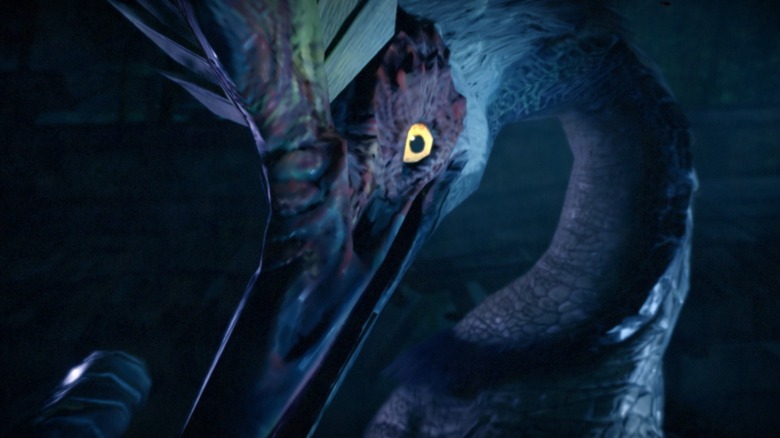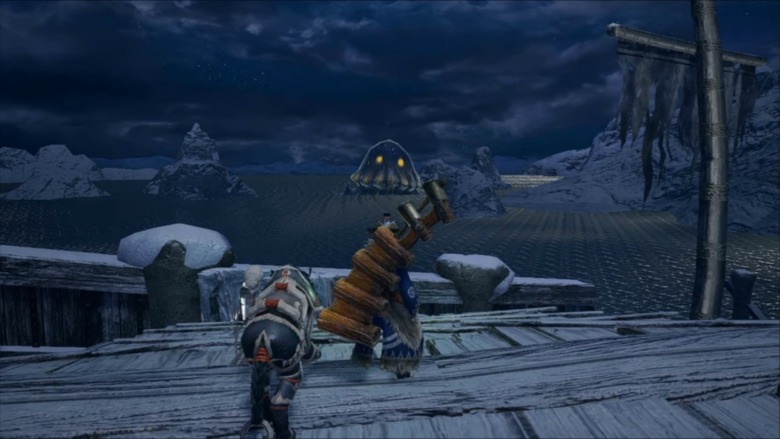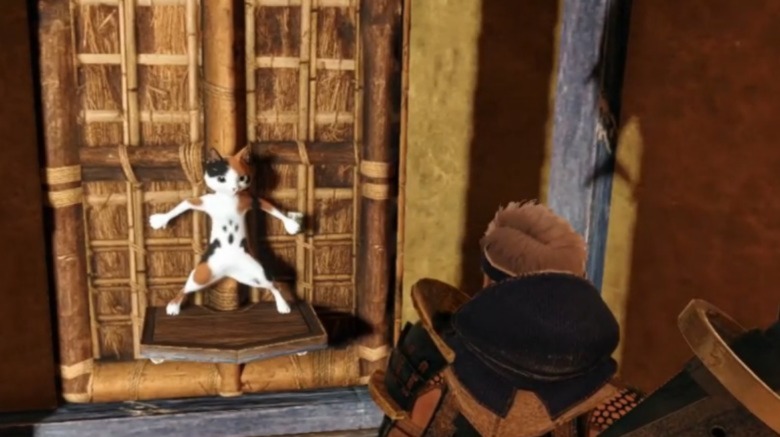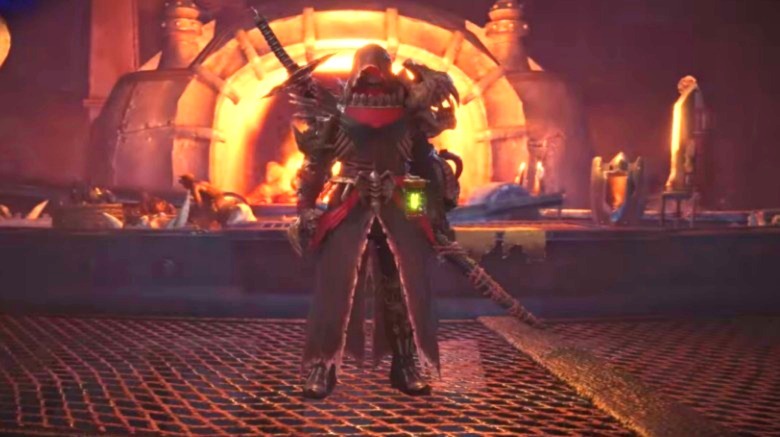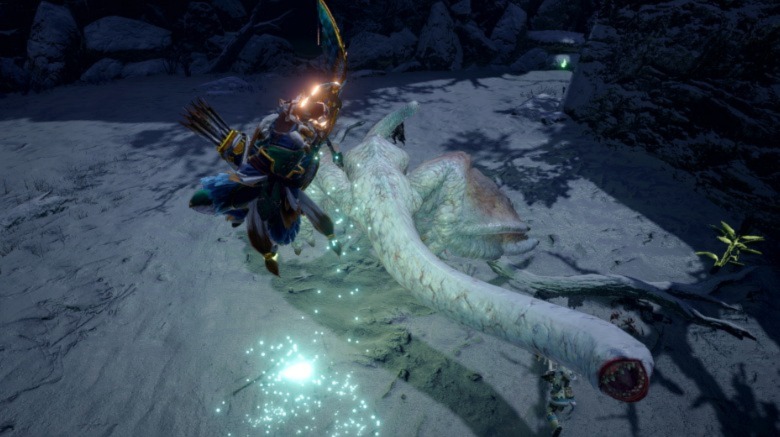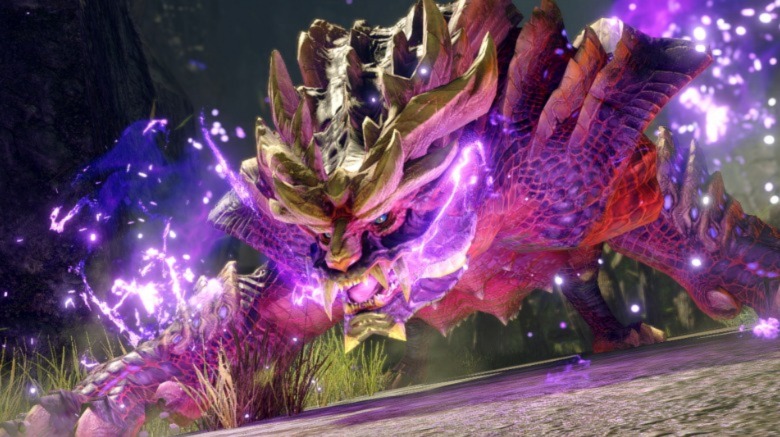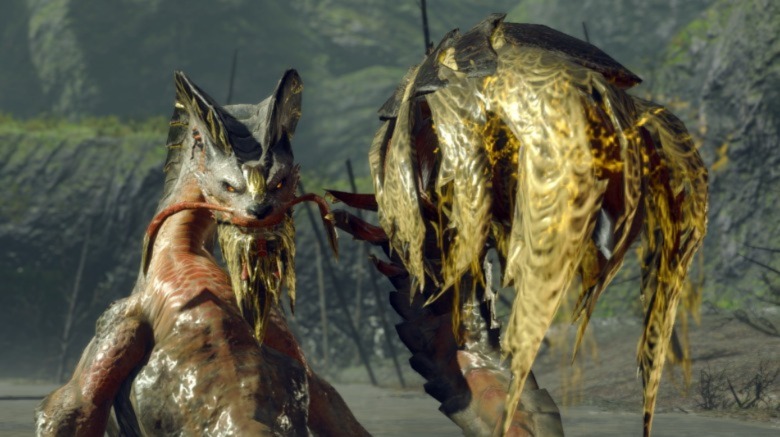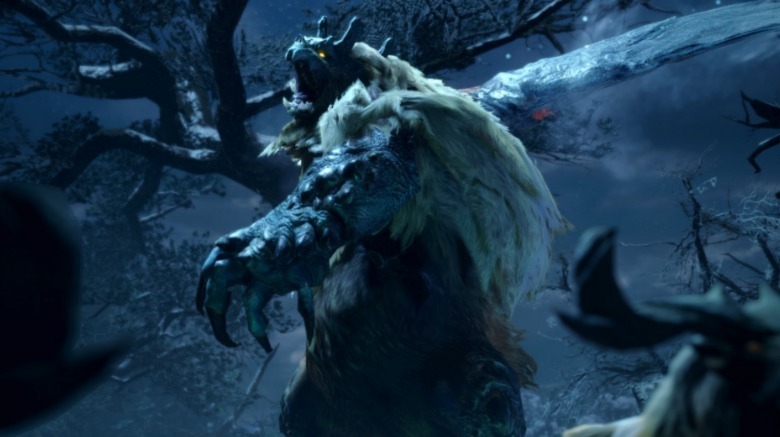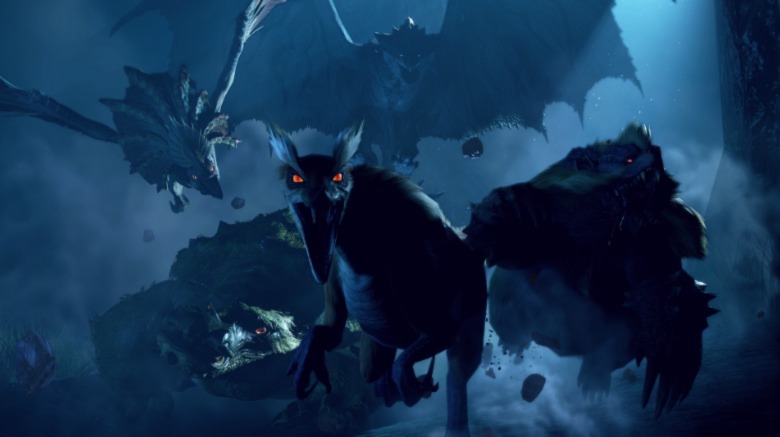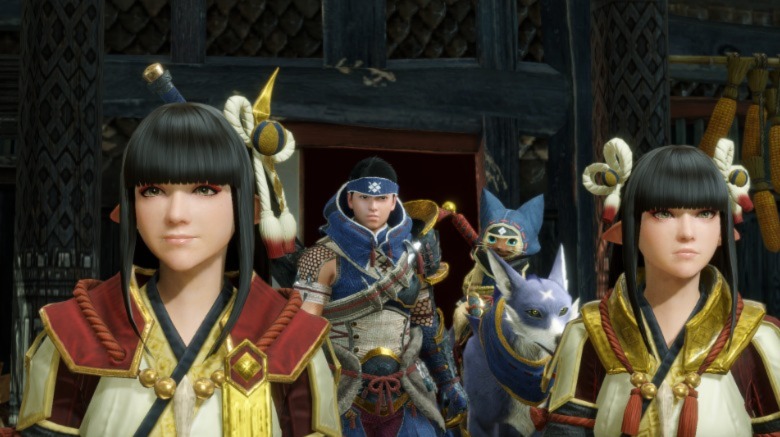The Creepiest Things We Found In Monster Hunter Rise
When you play a "Monster Hunter" game, you make several assumptions. You expect a tough-yet-fair challenge, an addictive gameplay loop of hunting big monsters and using their body parts to craft armors and weapons to hunt even bigger monsters, and awesome music. You do not expect to encounter anything scary — perhaps daunting, but not scary. While Capcom usually leaves the horror to "Resident Evil," the developers of "Monster Hunter" occasionally cross the genre rubicon.
Every now and then, "Monster Hunter" drops a few creepy details into the games. Sometimes these are hidden, such as the White Fatalis' lore — the creature is said to melt down hunters and turn their bodies into armor, which means players who make White Fatalis equipment are using the slagged remains of their fallen comrades. Other times, creepy details are in your face, like the horrifying nature of Vaal Hazak, which wears rotting meat as a coat and breathes a miasma that drains the life force of nearby creatures during combat. "Monster Hunter Rise" continues in this not-so-hidden tradition.
This latest entry in the "Monster Hunter" franchise includes quite a few items, scenes, monsters, and concepts that could be considered creepy, and here are the ones we found.
Warning: spoilers ahead for Monster Hunter Rise.
The Monksnail
The "Monster Hunter" gameplay loop is all about killing giant apex predators that threaten the ecological sanctity of surrounding areas. Unfortunately, this has resulted in far too many players confusing these giant dragons and dinosaurs for endemic creatures that are part of the natural order. So, Capcom decided to carve an obvious line in the sand with harmless creatures literally called Endemic Life, and one rare example of Endemic Life is probably more terrifying than a Deviljho with a toothache.
If you visit the Frost Islands at night, stand on top of the destroyed ship in area 8, and stare out at the ocean, you might see a gigantic black "head" with two, beady yellow "eyes" rise from the icy depths. A terrifying sight to the uninitiated, it's actually a harmless creature known as the Monksnail. Moreover, the creature's ghastly appearance is easily explained: it's based on the mythical Japanese creature known as the Umi bōzu, which you might have fought in "Nioh."
However, even after you get over the initial terror of seeing the Monksnail, the creep factor doesn't die there since the creature has one final ghastly trick up its sleeve. Like most rare examples of Endemic Life, the Monksnail reacts to gestures and emotes. In other words, when you wave at the Monksnail, the Monksnail waves back ... and emits an earth-splitting howl.
Your room has an unwelcome Felyne problem
It takes a lot of energy to slay giant monsters, so players can eat a Thanksgiving meal's worth of calories before setting out, as well as sleep off battles in personal huts. Unlike other entries, "Monster Hunter Rise" parades a distinctly Japanese aesthetic which replaces the normal gourmets with colorful dumpling balls, and the player's hut now has a hidey hole that lets ninjas spy on them. Wait, what?
If you examine the mural in your character's home, it swivels around to reveal a sneaky Felyne named Fukashigi the Informant, who has the lowdown on Kamura Village NPCs. The game plays the encounter for laughs since the information he provides is borderline useless, but when you think about it, Fukashigi's presence is scary in a Cold War espionage/Peeping Tom sort of way.
Fukashigi is clearly on a mission to gather intel about the residents of Kamura Village, and he converted part of your house into a spy nest. Whether or not you find him, the game implies that he's always watching the protagonist whenever they sleep or change clothes. Given the information Fukashigi retrieved, he's probably done the same with everyone else in the village. It's one of those low-key frights that only become scary when you stop to think about it.
Some armor sets don't match the overall friendly aesthetic
Half the fun/point of "Monster Hunter" is forging new equipment out of your previous hunts. Of course, Capcom inserted several degrees of separation between the monster parts and the resulting items' appearances, with equipment only emulating the aesthetics of monsters. The resulting armor sets are usually family friendly, but some sets in "Monster Hunter Rise" break this trend. No, they don't look like they were stitched together from corpses, but they are supernaturally macabre.
While most "Monster Hunter Rise" armor pieces are fun items that reflect the quality of materials used, others look like they could scare a Tigrex silly. For example, the Skull Visage mask hides the hunter's face underneath a demonic skull, and since its item description states that owners "may hear bumps in the night," it might be haunted.
However, the award for creepiest armor in "Monster Hunter Rise" easily goes to the Death Stench set, since each piece of equipment is probably cursed. The Death Stench Brain helmet's description states that users "faintly hear the sobs of the dead," while the Death Stench Bowels waist armor permanently stinks of decay. The associated weapons don't provide much levity, as the Graceful Death hammer "grips the souls of those it has reaped." That sounds almost out of place in a world with lightning unicorns and sand whales.
Khezu. Everything Khezu
Nature can be absolutely terrifying. You've got leeches that stretch far longer than you think possible to suck blood and eels that can electrocute you. The Khezu, which was absent from "Monster Hunter World" and returns in "Monster Hunter Rise," combines countless creepy crawlies into one terrifying creature.
Khezu is the stuff of nightmares. It has a pale, rubbery hide; electricity-producing glands; and a telescoping, eyeless mouth for a head. Oh, and Khezu have creepy red lips. However, its upsetting nature doesn't end there — it also extends to equipment made from Khezu parts.
While armor sets made out of Khezu parts appear normal (even if they look like they should squeak like rubber gloves), Khezu weapons are as macabre as the source monster. The Khezu hammer, the Bag o' Horrors/Bag o' Thunder, looks like a Khezu's head gruesomely stretched over a normal hammer, complete with a crudely tied-off neck. Furthermore, the weapon description states that nobody knows what's inside, and that they're better not knowing, given the stench.
Meanwhile, the Khezu hunting horn, the Khezu Horn/Khezu Flute, looks as if it were made from the hastily bandaged head and neck of a Khezu and nothing else. Even the noise it makes sounds like haunting monster cries, which surprisingly isn't half as creepy as the human-like wails of the Red Khezu horn.
Magnamalo can double jump
Every new "Monster Hunter" game features a new face, colloquially known as a flagship monster. For "Monster Hunter Rise," that crown belongs to a giant tiger with samurai bone armor, Magnamalo. This creature is commonly seen during Rampage quests, so initially, NPCs believe it is the ringleader that whips beasts into a frenzy with its bladed tail and Hellfire. However, what makes Magnamalo and its Hellfire truly frightening is their ability to defy physics.
If a Magnamalo shows up during a normal mission and encounters a flying monster like Rathalos or Aknosom, it will engage in a turf war. You might think that since Rathalos and Aknosom have wings and Magnamalo doesn't, it would be a one-sided fight, and it is ... for Magnamalo. It trounces these flyers by jumping on top of them, and whenever they toss Magnamalo off, it just ignites the Hellfire in its feet to double jump back on them. Eventually, a rocketeering bone tiger is just too much for them, and Magnamalo ignites the Hellfire in its feet once more to turn itself into a missile. The resulting impact crater demonstrates the difference in power.
While not creepy in a traditional sense, the knowledge of what fighting a Magnamalo would be like if it double jumped around is enough to send shivers down a player's spine.
The inspiration of Almudron
It's difficult to manufacture unique monster designs in video games, especially in one like "Monster Hunter," which has been around for almost two decades. But some game developers use surprising inspirations. Thanks to IGN, it's essentially common knowledge that the designers of "Monster Hunter Rise" drew from the overflowing well of Japanese yokai. Most of the game's newcomers are based on powerful/famous yokai, but the Almudron defies that trend because its inspiration terrifies people not by power, but by sight and sound alone.
At first glance, Almudron looks like a Mizutsune that took a permanent mud bath. The creature slings weaponized mud because of its inspiration: the dorotabō, literally translated as "muddy rice field monk." You might think dorotabō drags victims down to a mucky grave; instead, it is a spirit of vengeance that crawls through muddy rice fields and screams at people during the night.
If the idea of someone constantly yelling at you at night is creepy enough, wait until you get a good look at the dorotabō: emaciated and bald with three fingers, one eye, and covered in muck. Also, the yokai is usually depicted from the waist-up, so you don't know if it has legs. Unlike most yokai, the dorotabō isn't known for attacking people, but its appearance and behavior are more than enough to frighten people to death.
Goss Harag is a slasher villain
The new icy Fanged Beat of "Monster Hunter Rise," Goss Harag, is intimidating by design. The creature looks like an ugly cross between a polar bear and a Yeti, and even though it walks on all fours, the Goss Harag fights on two legs while hunched over, which adds several points to its menace factor. Also, the monster can freeze its bodily fluids (the game doesn't specify which ones) to create ice machetes, and its face looks like Barry the Chopper from "Fullmetal Alchemist." But that's not the creepiest part.
If a player is stunned during a Goss Harag fight, the monster will slowly saunter up to them, taking its sweet time and enjoying every step as if it were a slasher villain. The creature will even ignore other hunters while it stalks the dazed character. If a player doesn't snap out of it before the Goss Harag brings its blades down, they're gonna get hurt big time.
While the Goss Harag's overall appearance was based on a specific variant of Japanese oni known as the namahage (via IGN), its behavior seems to have more in common with Jason Voorhees.
The Rampage isn't just a new game mode
Even though the core gameplay loop of "Monster Hunter" is a fun monster hunt, players can only track and kill creatures so many times before the process becomes stale. To help potentially alleviate the boredom, Capcom introduced the Rampage, a new tower defense-like mode where hunters fend off waves of monsters that have declared war on the gates of Kamura Village. On the surface, it seems like just any other tower defense experience with some "Monster Hunter" flare, but since the participating creatures were drawn from terrifying Japanese myths, their rampage is also rooted in an equally terrifying procession.
According to the game's director, Yasunori Ichinose (via IGN), the Rampage is based on the mythical "Night Parade of One Hundred Demons." In many stories, the Night Parade is seemingly as orderly as a Thanksgiving Day parade, but nobody knows for sure since nobody has actually seen it. In Japanese legend, anyone who dares to lay eyes on the parade is gruesomely killed or kidnapped.
While the Rampage is terrifying, the "Night Parade of One Hundred Demons" is far more chilling since its victims are defenseless. A sword, a few good friends, and some well-placed ballistae can fend off a Rampage, but the only thing between you and Night Parade ghosts is a prayer.
Hinoa and Minoto have the Shining
Even though "Monster Hunter" tasks players with slaying dragons and dinosaurs, it tries to keep things as realistic as possible — relatively speaking. Monster elemental attacks are usually explained by specialized glands, but Elder Dragons don't have them. In "Monster Hunter" mythology, the Elder Dragons' abilities are downright supernatural, and in the case of "Monster Hunter Rise," chilling.
Magnamalo might be the face on the game's cover, but players eventually discover that the Rampage is caused by monsters trying to escape the destructive mating ritual of Wind Serpent Ibushi and Thunder Serpent Narwa — Kamura Village is just in their way. Stranger yet, NPCs Hinoa and Minoto can psychically sense these flying serpents. However, the connection goes both ways. When players first encounter Ibushi, the beast temporarily (and terrifyingly) puppeteers Hinoa's vocal cords to communicate. Eventually, players slay Ibushi and Narwa, or at least it seems that way before the end-credits scene.
While most NPCs celebrate, Hinoa and Minoto are under a trance, praising the child of Ibushi and Narwa. Not only does this chilling scene indicate that the hunt isn't over yet (which is good for players who want more story content), but it raises the question of how much control these Elder Dragons can exert. Could they turn Hinoa and Minoto against players? That's a question nobody wants answered.

